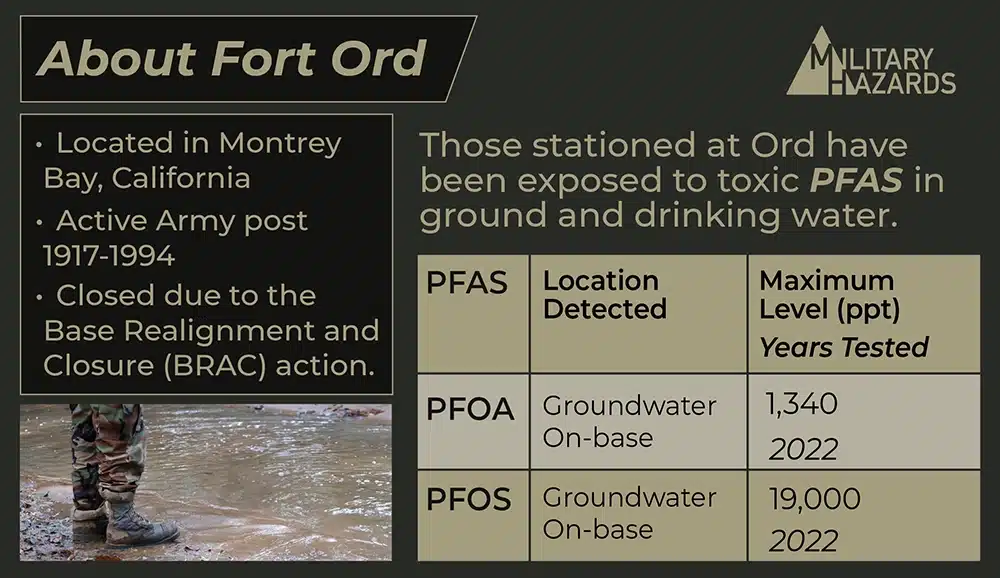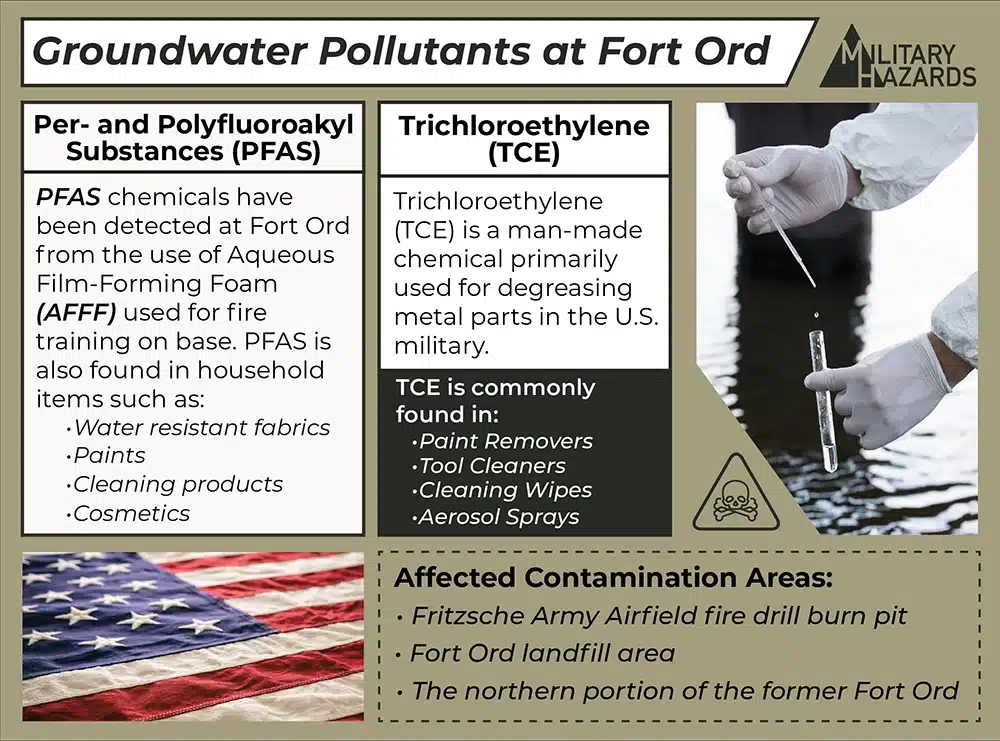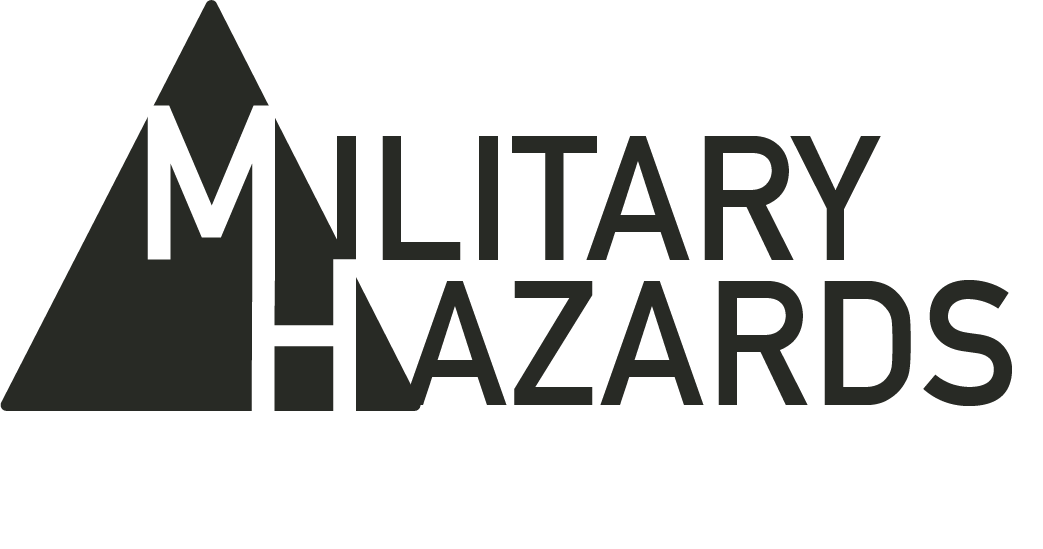Contact Our Legal Partner
"*" indicates required fields

Fort Ord was a U.S. Army post located on Monterey Bay in California, operational from 1917 to 1994. Before Fort Ord opened, the land belonged to the Costanoan Indians who still use it for hunting and fishing today, a huge risk with toxic forever chemicals in the water supply. It was closed in 1994 as part of the Base Realignment and Closure (BRAC) action.
The majority of the former base is now Fort Ord National Monument, managed by the U.S. Bureau of Land Management, with a small portion still active as the Ord Military Community.
While the base may be closed, the ongoing damage caused to service members and the wider community continue to dog the history of the former active military base.

Water Contamination Updates at Ford Ord Air Base
2022: New tests showed extremely dangerous levels of PFAS, with 19,000 ppt of PFOS, 1,340 ppt of PFOA, and 47,555 ppt of total PFAS in groundwater at Ford Ord.
2019: Tests conducted by the Army found PFOA at 113 parts per trillion (ppt) and PFOS at 447 ppt in groundwater.
1970s: The Department of Defense (DOD) slowly became aware of the adverse health effects of PFAS.

The Story Behind Fort Ord’s Water Contamination
According to the Army’s Fort Ord Cleanup program, groundwater contamination at Fort Ord was initially discovered in the mid-80s. Extensive investigations revealed a range of contaminants in the groundwater, including volatile organic compounds (VOCs) such as trichloroethylene (TCE).
In 1990, Fort Ord was added to the National Priorities List as a “Superfund” site by the U.S. Environmental Protection Agency (EPA). Although the base was officially closed in 1994, cleanup efforts have continued due to the extensive contamination.
Recent sampling of the groundwater at Fort Ord has detected the presence of per- and polyfluoroalkyl substances (PFAS), including perfluorooctane sulfonate (PFOS) and perfluorooctanoic acid (PFOA). These chemicals have been linked to an increased risk of cancer and other health issues.
The PFAS contamination at Fort Ord is believed to be the result of the military’s use of aqueous film-forming foam (AFFF), a fire suppressant used for decades in training exercises and to extinguish high-hazard fires. In May 2020, PFAS were detected in the groundwater below and around Fort Ord at concentrations of 560 parts per trillion, which is more than 20,000 times the limit considered dangerous by the EPA.
The Affected Contamination Areas at Fort Ord
The Army is currently cleaning up three main areas of groundwater contamination under the former Fort Ord. These areas include:
1. The Fritzsche Army Airfield fire drill burn pit (Operable Unit 1)
2. The Fort Ord landfill area (Operable Unit 2)
3. The northern portion of the former Fort Ord (Operable Unit Carbon Tetrachloride Plume)
Cleanup efforts include the operation of groundwater treatment facilities and the capping of the Fort Ord landfill. Due to the extensive contamination, the use of groundwater for drinking purposes is prohibited in certain areas.
What Contaminants Were Found at Fort Ord Air Force Base?
The following toxic chemicals were found:
1. PFAS (Per- and Polyfluoroalkyl Substances): Primarily PFOA and PFOS, found in groundwater at levels far exceeding EPA limits.
2. Trichloroethylene (TCE): A cancer-causing chemical found in drinking water.

How the Army Responded to Fort Ord’s Water Quality
While the Army claims that PFAS has not entered the region’s drinking water supply, the groundwater contamination levels are alarmingly high. The Army has built a water treatment facility to clean up trichloroethane, which also removes some toxic contamination, a measure some may say is 50 years too little too late as many service members struggle with being poisoned due to fire retardant foams.
Health Issues Associated With Drinking Water at Fort Ord
Contaminants at Fort Ord, including VOCs, TCE, and benzene, have been linked to various health risks, particularly cancers. Individuals stationed there for at least 30 days between 1917 and 1994 may be at significant risk. Veterans and their families should seek regular health checkups for early diagnosis and treatment of related illnesses. If you have concerns about exposure or unusual health symptoms, consult a medical professional familiar with military toxic exposures and discuss your service history for proper monitoring and care.
- Bladder Cancer
- Breast Cancer
- Kidney Cancer
- Leukemia
- Liver cancer
- Multiple-Myeloma
- Non-Hodgkin’s Lymphoma
- Pancreatic Cancer
- Prostate Cancer
- Testicular Cancer
- Thyroid Cancer
- Thyroid Disease
- Ulcerative Colitis
Can I File a Lawsuit for Fort Ord’s Water Contamination?
Veterans and their families who were stationed at Fort Ord and have developed life altering diseases related to PFAS exposure may be eligible for compensation. The Veterans Administration (VA) has recently awarded 100% disability to a Fort Ord veteran suffering from colon cancer, citing PFAS contamination.
Many families have found that it can be quicker to file a lawsuit rather than go through the red tape of the VA. If you need help with this, or one of your loved ones has been affected then we at Military Hazards are pleased to direct you to one of our vetted list of injury attorneys who will fight for you.
Potential Settlement Amounts From Water Contamination at Ford Ord
Settlement amounts for Fort Ord water contamination cases are expected to vary significantly. Factors influencing compensation include diagnosis, age at diagnosis, and ability to prove a connection between illness and water contamination at Fort Ord.
While settlement amounts are not yet established for Fort Ord specifically, based on similar cases, settlements may range from $30,000 to $500,000, with some potentially reaching $1,000,000. Cancer-related cases typically settle between $100,000 and $300,000. Younger individuals at diagnosis or those with extended illness may receive larger settlements. Cases with less proof or minor injuries may settle between $30,000 and $75,000.
The average settlement is anticipated to be around $250,000, though settlements are generally lower than potential trial verdicts. It’s important to note that there is no guarantee of a positive outcome, and actual amounts may vary based on the specific circumstances of each case.
Can I File a Fort Ord Water Contamination Lawsuit?
To file a Fort Ord water contamination lawsuit, consult with an attorney as soon as possible. An attorney can guide you through the process and provide necessary resources.
Guide to Filing a Fort Ord Water Contamination Lawsuit:
1. Determine Eligibility: An attorney can help verify if you meet the criteria, including proof of exposure and diagnosis of a related condition.
2. Collect Evidence: Gather medical records, expert testimonies, and environmental studies specific to Fort Ord.
3. File Your Case: With the evidence ready, an attorney will help file your case in the appropriate jurisdiction and meet all legal deadlines.
4. Negotiate a Settlement: Settlements can be negotiated at any stage of the case.
5. Prepare for Trial: If a settlement isn’t reached, your attorney will prepare to take the case to trial.
Acting promptly and securing strong evidence are key to a successful claim.
What Evidence Would I Need to Support My Claim?
To be eligible for the Fort Ord water contamination lawsuit, individuals typically must meet specific criteria:
- Documented exposure to contaminated water at Fort Ord
- Diagnosis of a condition potentially linked to the contaminants
- Evidence of residence or employment at Fort Ord during the contamination period
What Are the Filing Deadlines for a Lawsuit?
The statute of limitations for filing contamination claims can vary significantly based on state laws and the specifics of each case. It is essential to consult with an experienced attorney to understand the applicable deadlines and ensure your claim is filed within the required timeframe. This will help protect your rights and increase the likelihood of a successful outcome.
Who Can I Speak With About My Case?
Several law firms specialize in military base water contamination lawsuits, including those related to Fort Ord. However, MilitaryHazards.org has found the highest rate of success with preferred firms on our list based on debriefs from former troupe members. Reach out to the staff at MilitaryHazards.org and we will recommend attorneys with expertise in environmental and military-related cases, particularly those involving PFAS contamination for the best chance of winning your case.
